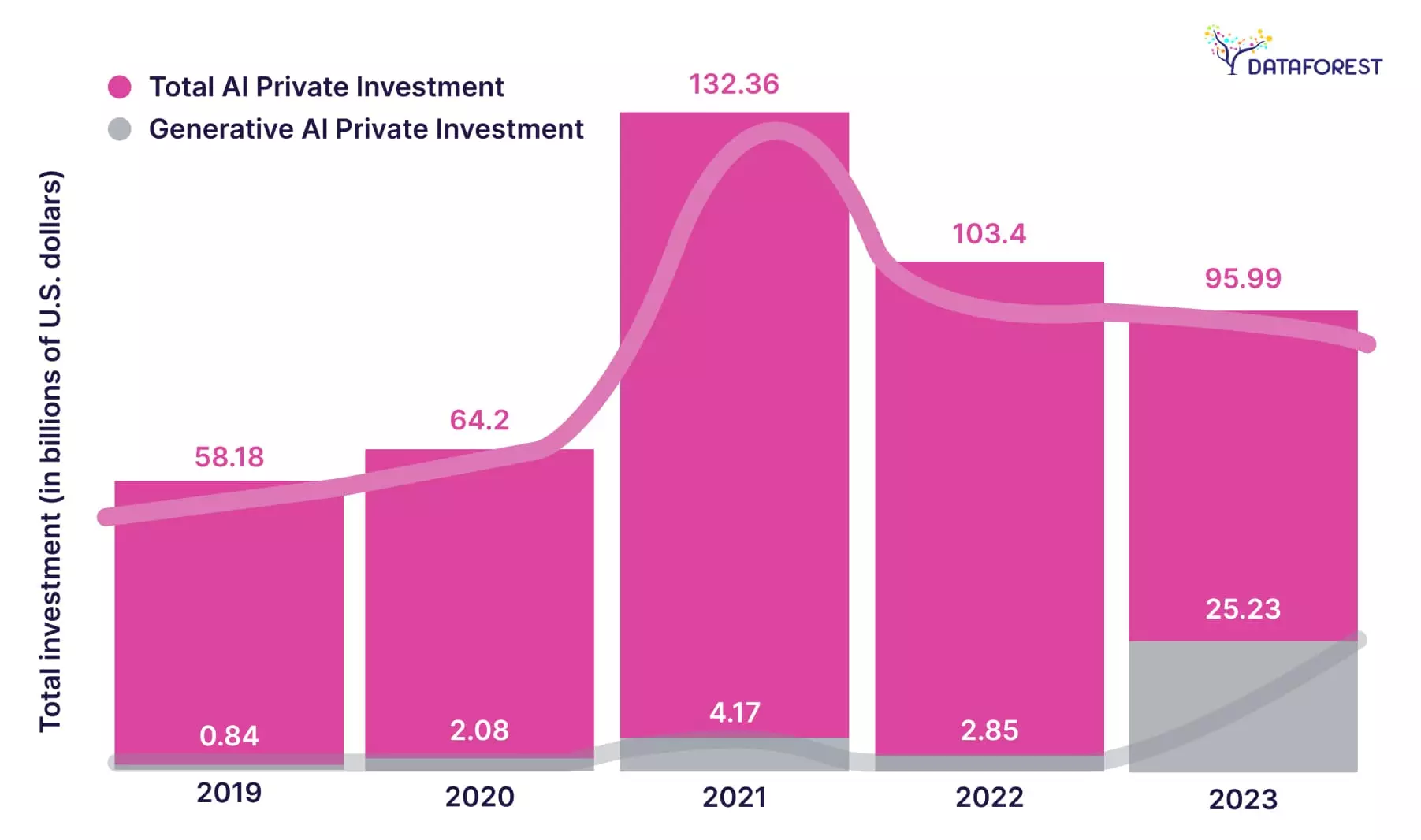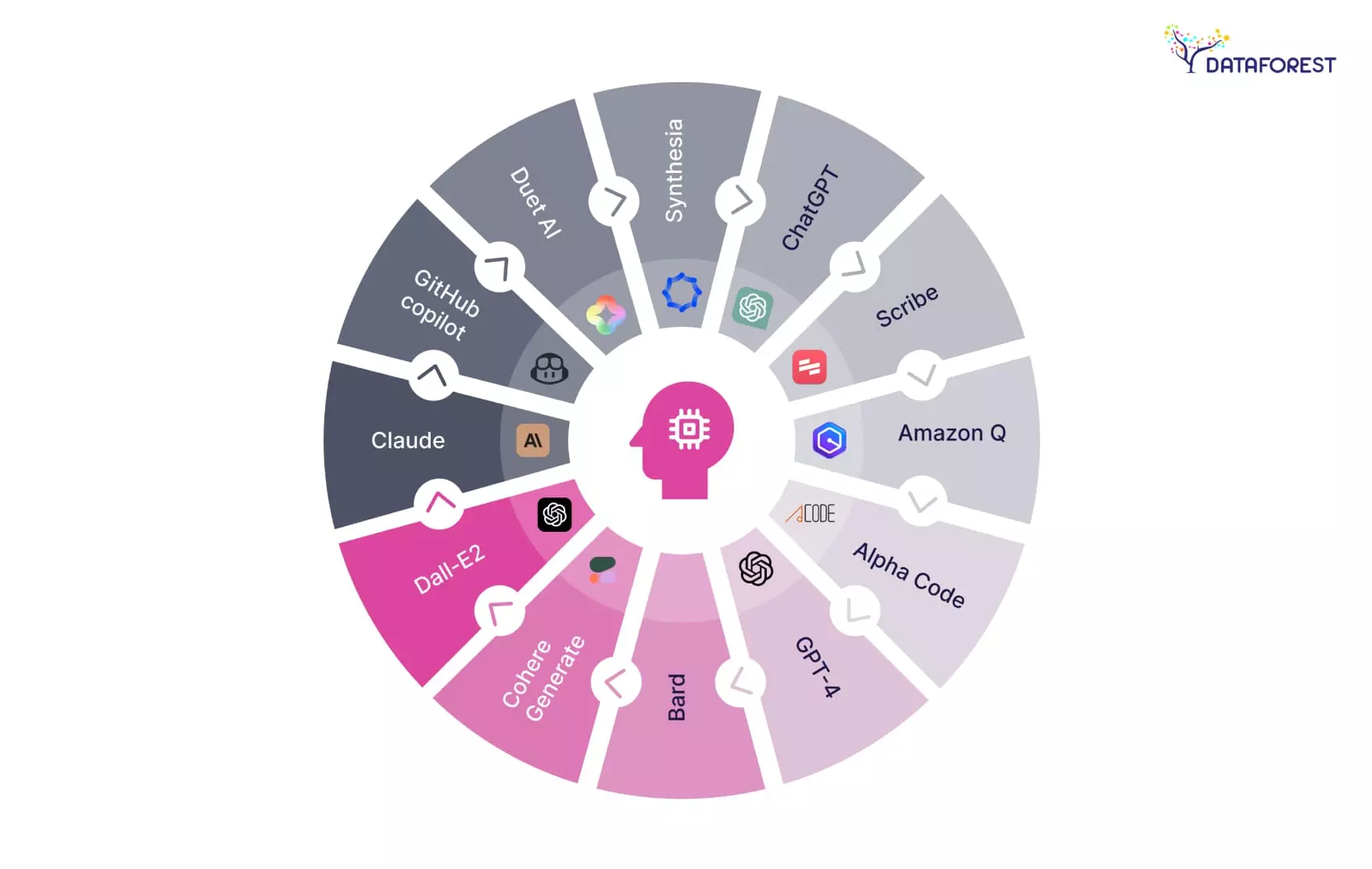Generative AI thrives on two main ingredients: powerful algorithms and vast data. At its core lies complex algorithms like deep learning neural networks. They sift through massive text, code, images, or music datasets, learning to recognize these elements and the hidden rules. This allows them to generate entirely new creations inspired by but distinct from the data they've seen. Data acts as the fuel for generative AI. The more information it has to work with, the more its creations become refined. Generative AI is a sculptor with a vast quarry, where the variety and complexity of the data fuel its creative potential.

Staying Ahead of the Gen AI Curve Matters
Generative AI, the technology behind everything from creating realistic images to crafting captivating stories, is evolving quickly. But why should you care about keeping up with the latest trends as an individual or a whole company?
Because it creates more believable graphics, composes music that rivals human composers, or develops AI assistants that can answer questions and anticipate your needs. By staying current, you'll be the first to leverage these advancements. Keeping up with Generative AI trends allows you to develop relevant skills and stay competitive.
Like any powerful technology, Generative AI has unforeseen consequences. Staying informed allows you to anticipate potential disruptions and navigate ethical considerations.
Strategies to Power Generative AI
Generative AI has immense potential to revolutionize various fields. However, we need to fuel its development to unlock its full potential.
Investment in Generative AI R&D
Investment in research and development (R&D) is the seed from which groundbreaking advancements in this technology will blossom. R&D fosters the exploration of novel algorithms, model architectures, and training methodologies. This pushes the boundaries of what generative AI can achieve. By funding research labs and initiatives, we accelerate the pace of discovery. This translates to faster development cycles, bringing generative AI solutions to the forefront sooner. R&D encourages diverse research teams' participation, fostering many perspectives.
Collaboration and Partnership in the Generative AI Ecosystem
Collaboration bridges the gap between academia, research institutions, and industry leaders. This allows for a symbiotic exchange of knowledge. Researchers provide ideas, while industry leaders offer practical use cases and real-world datasets. By combining expertise and resources, collaborative efforts accelerate the pace of innovation. Shared knowledge and insights lead to more efficient problem-solving and the development of more robust generative AI solutions. Partnerships bring together diverse perspectives. The cross-pollination of ideas promotes a richer pool of solutions and mitigates potential biases. Generative AI has the potential to solve complex challenges in various fields. Collaboration allows for pooling of resources and expertise and enables tackling large-scale projects.
Data Accessibility and Quality as the Fuel for AI
Generative AI thrives on data, the fuel that powers its ability to learn, create, and innovate. As an engine sputters without high-quality fuel, generative AI models need access to extensive, high-quality data to reach their full potential. Generative AI models learn by analyzing massive amounts of data. This data serves as the training ground, informing the model's understanding of patterns, relationships, and underlying structures. Access to a wide variety of data ensures the model is exposed to a broad spectrum of information. The quality of the data directly impacts the quality of the generated output. Clean, well-labeled, and error-free data allows generative AI models to produce superior results. Accessible and high-quality data is a CDO's problem, and it empowers researchers and developers to experiment with new generative AI applications.
Ethical Considerations and Responsible AI Practices
As generative AI's capabilities flourish, so does the need for ethical considerations and responsible development practices. While generative AI offers immense potential, ethical pitfalls and unintended consequences can arise if not addressed proactively. Generative AI models can perpetuate biases in the data vectors they are trained on. By implementing fairness checks and mitigation strategies, we ensure the technology promotes inclusivity and avoids discriminatory outputs. Generative AI models can be complex. Stimulating transparency in how models arrive at their outputs is essential to build trust and ensure responsible use. This allows users to understand the reasoning behind generated content. Establishing safeguards and detection mechanisms is key to preventing this technology's misuse and addressing the business's pain points. As generative AI becomes more sophisticated, clear lines of accountability must be established. Determining who is responsible for the outputs of generative models is essential for responsible use.
Talent Acquisition and Training for Generative AI
Generative AI's potential rests on technological advancements and the human expertise guiding it. To unlock its full potential, we need to cultivate a skilled workforce well-versed in this evolving field's intricacies. Generative AI necessitates a unique skill set encompassing expertise in machine learning, data science, and software development. Targeted talent acquisition strategies that attract individuals with these qualifications are essential. A skilled workforce is the brain thrust behind generative AI advancements. Investing in talent acquisition ensures we have the expertise to develop, maintain, and deploy generative AI solutions effectively.
Investing in training programs for existing IT professionals ensures they possess the up-to-date knowledge necessary to work effectively with generative AI models. By nurturing a skilled workforce, we lay the foundation for the future of generative AI.
Investing in Infrastructure and Computing Resources
Generative AI models are computationally intensive, requiring vast processing power to train and generate outputs. Investing in high-performance computing infrastructure, including GPUs and specialized hardware, empowers these models to reach their potential. As generative AI models become more complex, their computational demands will also increase. Building a scalable infrastructure ensures we can handle these ever-growing requirements. Robust infrastructure allows for faster and more efficient model training. This translates to quicker development cycles and the ability to rapidly experiment with new generative AI applications.
Cloud computing offers a flexible and scalable solution for accessing the computational resources needed for generative AI. Investing in cloud-based infrastructure provides a cost-effective way to meet the ever-changing needs of generative AI development.
The immense computational power required by generative AI models raises concerns about energy consumption. Energy-efficient hardware and infrastructure are pivotal for sustainable development.
Regulatory Compliance and Data Privacy
Generative AI's potential is undeniable, but its growth must be accompanied by a solid framework to ensure responsible development and ethical use. Clear regulations and data privacy measures aid trust in generative AI. Data privacy regulations ensure that structured and unstructured data from different sources is collected, stored, and used responsibly. Regulations help mitigate the misuse of generative AI for malicious purposes, such as spreading misinformation or creating deepfakes. Establishing guidelines for fair and unbiased model development ensures the technology benefits everyone equally. Knowing the boundaries and limitations allows developers to responsibly push the frontiers of generative AI.

Generative AI Vendors: Igniting the Spark in Businesses
Generative AI vendors offer a range of solutions (and DATAFOREST does the same), from user-friendly cloud platforms to pre-trained models and APIs. This makes generative AI more accessible to businesses of all sizes. Vendors provide pre-built tools and libraries that simplify the development process for businesses. This allows them to leverage generative AI capabilities without building complex models from scratch. They also suggest valuable expertise and support throughout the development and implementation process and assist businesses in selecting the right tools, customizing models for specific needs, and troubleshooting any challenges encountered. Vendors constantly improve their offerings, ensuring businesses can access the latest advancements. Solutions are designed to be scalable and flexible. Please fill out the form, and let's get generative AI to capacity.
FAQ
What are the potential benefits of integrating generative AI into our business operations?
Generative AI unlocks increased efficiency and creativity in your business by automating tasks and generating innovative ideas based on data analysis. This leads to faster product development, improved marketing campaigns, and overall business growth.
How can businesses ensure the accessibility and quality of data used to fuel generative AI models?
Businesses prioritize data accessibility by investing in strategies like data labeling and creating data-sharing platforms. Ensuring high-quality data requires implementing practices for data cleaning, error correction, and maintaining diverse datasets to mitigate bias.
What types of businesses can benefit from implementing generative AI?
Industries that rely heavily on content creation, like marketing and media, can leverage AI to generate fresh ideas and automate tasks. Sectors involving complex data analysis, such as finance and healthcare, utilize generative AI to extract insights and identify patterns that humans might miss.
What are some practical steps for implementing generative AI in our business, especially if we lack internal AI expertise?
If your business lacks in-house AI expertise, you can still leverage generative AI by partnering with vendors who offer user-friendly cloud platforms and pre-trained models. These vendors often provide training and support throughout the process, allowing you to customize these models for your needs and integrate them into your existing workflow without building everything from scratch.







.svg)
.webp)















